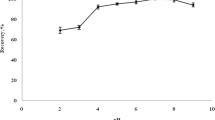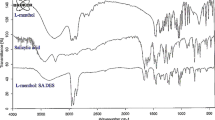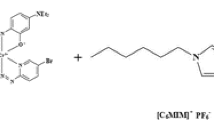Abstract
In this study, a new low-density solvent-based dispersive liquid–liquid microextraction strategy coupled to spectrophotometry has been developed for the determination of the trace levels of histamine in fish and meat products. The method is based on the formation of a charge transfer complex between a histamine and a phenothiazine group dye, promethazine (PMZ) in the presence of greener ionic liquid (IL), 1-butyl-3-methylimidazilium octylsulfate, C4mim octylOSO3, exhibiting a surfactant-like micellar behavior at pH 7.0, and then microextraction of the complex into the floating organic drops of 1-heptanol, which is water-immiscible and lighter than water. Ultrasound or sonication was used to improve the microextraction efficiency as well as to reduce the analysis time and cost. Variables affecting the microextraction efficiency were evaluated and optimized. Under optimal conditions, a calibration plot, which is prepared from solvent-based calibration solutions, was linear in the range of 5–750 μg L−1, with a sensitivity enhancement of 95-fold. In addition, the satisfactory extraction recoveries ranging from 95.2 to 102.8% were obtained. The method has been found to have excellent detection sensitivity, with a detection limit of 1.35 μg L−1 and intra- and inter-day precisions of 3.5–5.6% (as RSDs; n, 5 and 3 × 5). A preconcentration factor of 107-fold from the preconcentration of a 75-mL sample was obtained. The method was statistically validated by analysis of two quality control samples, including accuracy and precision studies after spiking. The method may be accepted as a simple, easy-to-use, low-cost, fast, sensitive, accurate, and reliable approach, even better than conventional DLLME and similar techniques. The results indicated that this methodology was suitable for the analysis of low levels of histamine in selected food matrices.


Similar content being viewed by others
References
Alam MS, Naqvi AZ (2007a) Tuning of the cloud point of promethazine hydrochloride with surfactants and polymers. J Surfactant Deterg 10(1):35–40
Alam MS, Naqvi AZ (2007b) Influence of electrolytes/non-electrolytes on the cloud point phenomenon of the aqueous promethazine hydrochloride drug solution. J Colloid Interface Sci 306:161–165
Alam MS, Naqvi AZ (2008) Cloud point phenomenon in amphiphilic drug promethazine hydrochloride-electrolyte systems. J Dispers Sci Technol 29(5):783–786
Alam MS, Naqvi AZ, Mandal AB (2010) Amphiphilic drug promethazine hydrochloride-additive systems: evaluation of thermodynamic parameters at cloud point. J Chem Eng Data 55:1893–1896
Altieri I, Semeraro A, Scalise F, Calderari I, Stacchini P (2016) European official control of food: determination of histamine in fish products by a HPLC–UV-DAD method. Food Chem 211:694–699
Altunay N, Gürkan R (2016) A new simple UV-vis spectrophotometric method for determination of sulfite species in vegetables and dried fruits using a preconcentration process. Anal Methods 8(2):342–352
Altunay N, Demir Ö, Gürkan R (2017) Ionic liquid based ion-pairing microextraction combined with spectrophotometry for preconcentration and quantitation of melamine in milk and milk-based products. LWT- Food Sci Technol 86:352–360
Amorim CG, Souza RC, Araújo AN, Montenegro MCBSM, Silva VL (2010) SI lab-on-valve analysis of histamine using potentiometric detection for food quality control. Food Chem 122(3):871–876
Barhoumi Z, Saini M, Amdouni N, Pal A (2016) Interaction between amphiphilic ionic liquid 1-butyl-3-methylimidazolium octyl sulfate and anionic polymer of sodium polystyrene sulfonate in aqueous medium. Chem Phys Lett 661:173–178
Chang SY, Jayb T, Muñoz J, Kim I, Kendall H, Lee KH (2012) Wireless fast-scan cyclic voltammetry measurement of histamine using WINCS-a proof-of-principle study. Analyst 137(9):2158–2165
Cohen G, Rudnik DD, Lalous M, Yakir D, Karpas Z (2015) A novel method for determination of histamine in tuna fish by ion mobility spectrometry. Food Anal Methods 8(9):2376–2382
Daniel D, Dos Santos VB, Vidal DTR, Lago CL (2015) Determination of biogenic amines in beer and wine by capillary electrophoresis–tandem mass spectrometry. J Chromatogr A 1416:121–128
Dávila MJ, Aparicio S, Alcalde R, García B, Leal JM (2007) On the properties of 1-butyl-3-methylimidazolium octylsulfate ionic liquid. Green Chem 9(3):221–232
Degefu H, Amare M, Tessema M, Admassie S (2014) Lignin modified glassy carbon electrode for the electrochemical determination of histamine in human urine and wine samples. Electrochim Acta 121:307–314
Dhanalakshmi B, Sailaja BBV (2014) Protonation equilibria of glycylglycine and histamine in aqueous solution of an anionic surfactant. Chem Speciat Bioavailab 26(1):52–58
Gao F, Grant E, Lu X (2015) Determination of histamine in canned tuna by molecularly imprinted polymers-surface enhanced Raman spectroscopy. Anal Chim Acta 901:68–75
Grant FS (2011) Fish and fishery products hazards and controls guidance, 4th edn. Center for Food Safety and Applied Nutrition, USA, pp 24040–22300
Jain A, Gupta M, Verma KK (2015) Salting-out assisted liquid–liquid extraction for the determination of biogenic amines in fruit juices and alcoholic beverages after derivatization with 1-naphthylisothiocyanate and high performance liquid chromatography. J Chromatogr A 1422:60–72
Jastrzębska A, Kurzawa M, Piasta A, Szłyk E (2012) Determination of histamine in some foods by isotachophoretic method with simple sample preparation. Food Anal Methods 5(5):1079–1087
Junior DS, Krug FJ (2006) Currents on ultrasound-assisted extraction for sample preparation and spectroscopic analytes determination. Appl Spectrosc Rev 41:305–321
Kabir-ud-Din RMA, Alam MS (2010) Micellization and clouding phenomenon of phenothiazine drug promethazine hydrochloride: effect of NaCl and urea addition. J Dispers Sci Technol 31:1182–1187
Karpinska J, Starczewska B, Puzanowska-Tarasiewicz H (1996) Analytical properties of 2- and 10-disubstituted phenothiazine derivatives. Anal Sci 12:161–170
Khan MK, Chemat F (2011) Application of low and high power ultrasound in food analysis. Anal Chem Lett 1(1):103–114
Khan S, Carneiro LS, Vianna MS, Romani EC, Aucelio RQ (2017) Determination of histamine in tuna fish by photoluminescence sensing using thioglycolic acid modified CdTe quantum dots and cationic solid phase extraction. J Lumin 182:71–78
Kumar D, Rub MA (2017) Effect of anionic surfactant and temperature on micellization behavior of promethazine hydrochloride drug in absence and presence of urea. J Mol Liq 238:389–396
Liu J, Wang L, Hu W, Chen X, Zhong D (2014) Development of a UHPLC–MS/MS method for the determination of plasma histamine in various mammalian species. J Chromatogr B 971:35–42
Mahajan S, Mahajan RK (2013) Interactions of phenothiazine drugs with surfactants: a detailed physicochemical overview. Adv Colloid Interf Sci 199–200:1–14
Miskolcz Z, Sebok-Nagy K, Biczok L, Gokturk S (2004) Aggregation and micelle formation of ionic liquids in aqueous solution. Chem Phys Lett 400:296–300
Moradi M, Yamini Y, Esrafili A, Seidi S (2010) Application of surfactant assisted dispersive liquid-liquid microextraction for sample preparation of chlorophenols in water samples. Talanta 82(5):1864–1869
Moradi M, Yamini Y, Baheri T (2011) Analysis of abuse drugs in urine using surfactant-assisted dispersive liquid-liquid microextraction. J Sep Sci 34(14):1722–1729
Muscarella M, Magro SL, Campaniello M, Armentano A, Stacchini P (2013) Survey of histamine levels in fresh fish and fish products collected in Puglia (Italy) by ELISA and HPLC with fluorimetric detection. Food Control 31(1):211–217
Nei D, Nakamura N, Ishihara K, Kimura M, Satomi M (2017) A rapid screening of histamine concentration in fish fillet by direct analysis in real time mass spectrometry (DART-MS). Food Control 75:181–186
Ordonez JL, Troncoso AM, Garcia-Parrilla MDC, Callejon RM (2016) Recent trends in the determination of biogenic amines in fermented beverages—a review. Anal Chim Acta 939:10–25
Pérez S, Bartrolí J, Fàbregas E (2013) Amperometric biosensor for the determination of histamine in fish samples. Food Chem 141(4):4066–4072
Saber-Tehrani M, Givianrad MH, Mahoor N (2012) Surfactant-assisted dispersive liquid–liquid microextraction followed by high-performance liquid chromatography for determination of amphetamine and methamphetamine in urine samples. Anal Methods 4:1357–1364
Santos B, Simonet BM, Ríos A, Valcárcel M (2004) Direct automatic determination of biogenic amines in wine by flow injection-capillary electrophoresis-mass spectrometry. Electrophoresis 25(20):3427–3433
Sarkar S, Mandal S, Pramanik R, Ghatak C, Rao VG, Nilmoni SN (2011) Photoinduced electron transfer in a room temperature ionic liquid 1-butyl-3-methylimidazolium octyl sulfate micelle: a temperature dependent study. J Phys Chem B 115:6100–6110
Singh T, Drechsler M, Müeller AHE, Mukhopadhyay I, Kumar A (2010) Micellar transitions in the aqueous solutions of a surfactant-like ionic liquid: 1-butyl-3-methylimidazolium octylsulfate. Phys Chem Chem Phys 12:11728–11735
Stojanović ZS, Švarc-Gajić JV (2011) A simple and rapid method for histamine determination in fermented sausages by mediated chronopotentiometry. Food Control 22(12):2013–2019
Stojanović ZS, Mehmeti E, Kalcher K, Guzsvány V, Stanković DM (2016) SWCNT-modified carbon paste electrode as an electrochemical sensor for histamine determination in alcoholic beverages. Food Anal Methods 9:2701–2710
Švarc-Gajić J, Stojanović Z (2011) Determination of histamine in cheese by chronopotentiometry on a thin film mercury electrode. Food Chem 124(3):1172–1176
Tzanavaras PD, Deda O, Karakosta TD, Themelis DG (2013) Selective fluorimetric method for the determination of histamine in seafood samples based on the concept of zone fluidics. Anal Chim Acta 778:48–53
Vitali L, Valese AC, Azevedo MS, Gonzaga LV, Costa ACO, Piovezan M, Vistuba JP, Micke GA (2013) Development of a fast and selective separation method to determine histamine in tuna fish samples using capillary zone electrophoresis. Talanta 106:181–185
Wang Y, You J, Ren R, Xiao Y, Gao S, Zhang H, Yu A (2010) Determination of triazines in honey by dispersive liquid–liquid microextraction high-performance liquid chromatography. J Chromatogr A 1217:4241–4246
Wasserscheid P, van Hal R, Bösmann A (2002) 1-n-Butyl-3-methylimidazolium ([bmim]) octylsulfate-an even ‘greener’ ionic liquid. Green Chem 4(4):400–404
Xie Z, Wang Y, Chen Y, Xu X, Jin Z, Ding Y, Wu F (2017) Tuneable surface enhanced Raman spectroscopy hyphenated to chemically derivatized thin-layer chromatography plates for screening histamine in fish. Food Chem 230:547–552
Yilmaz UT, Inan D (2015) Quantification of histamine in various fish samples using square wave stripping voltammetric method. J Food Sci Technol 52(10):6671–6678
Yoshida T, Hamada H, Murakawa H, Yoshimoto H, Tobino T, Toda K (2012) Determination of histamine in seafood by hydrophilic interaction chromatography/tandem mass spectrometry. Anal Sci 28:179–182
Acknowledgments
This study was supported by Cumhuriyet University Scientific Research Projects Commission as the research projects with the F-535 code.
Author information
Authors and Affiliations
Corresponding author
Ethics declarations
The authors have no financial relationship with the organization that sponsored the research.
Conflict of Interest
Adil Elik declares that he has no conflict of interest. Nail Altunay declares that he has no conflict of interest. Ramazan Gürkan declares that he has no conflict of interest.
Ethical Approval
This article does not contain any studies with human or animal subjects.
Informed Consent
On behalf of other authors, informed consent was obtained from all individual participants included in the study.
Additional information
Highlights
• A greener ionic liquid than conventional ionic liquids was used in the extraction process.
• Ionic liquid in 1-heptanol was used as both extractant and sensitivity enhancer counterion.
• This solvent was preferably used to control pH-sensitive electron transfer from donor to acceptor.
• The method shows good signal stability and a high preconcentration factor.
• The microextraction was applied to the preconcentration of histamine in selected foods.
Rights and permissions
About this article
Cite this article
Elik, A., Altunay, N. & Gürkan, R. Ultrasound-Assisted Low-Density Solvent-Based Dispersive Liquid–Liquid Microextraction Coupled to Spectrophotometry for the Determination of Low Levels of Histamine in Fish and Meat Products. Food Anal. Methods 12, 489–502 (2019). https://doi.org/10.1007/s12161-018-1380-1
Received:
Accepted:
Published:
Issue Date:
DOI: https://doi.org/10.1007/s12161-018-1380-1




